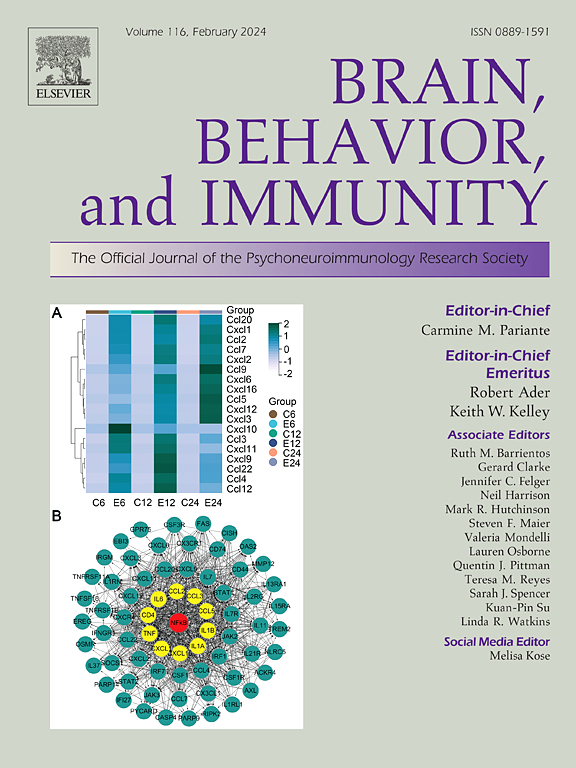脑脊液和血液特征支持边缘脑炎亚型的分类。
IF 8.8
2区 医学
Q1 IMMUNOLOGY
引用次数: 0
摘要
自身免疫性边缘脑炎(ALE)是一种异质性疾病,与针对细胞外表位(ALEextra)、细胞内表位(ALEintra)、抗谷氨酸脱羧酶65 ALE(ALEGAD65)和未检测到抗体的ALE(ALEabneg)的抗体有关。通过流式细胞仪对148名ALE患者(33名ALEextra、12名ALEintra、28名ALE-GAD65、37名ALEabneg)的血液和脑脊液(CSF)中的细胞参数、可溶性参数进行了综合分析、37 ALEabneg)与神经炎症性疾病(51 名复发性缓解型多发性硬化症患者 (RRMS))和神经退行性疾病(34 名阿尔茨海默病患者 (AD))的典型病例进行比较,发现 ALE 亚群中存在不同的免疫特征。ALE亚型特异性标记物的鉴定有助于对罕见的ALE相关肿瘤进行分类,这可能会促进临床实践中的进一步诊断工作。ALEintra表现出神经炎症的特征,而ALEextra则表现出神经炎症和神经变性的特征。此外,ALEGAD65 和 ALEabneg 缺乏炎症特征。这可能是 ALEGAD65 和 ALEabneg 抗炎治疗方案疗效不佳的原因。本文章由计算机程序翻译,如有差异,请以英文原文为准。
CSF and blood signatures support classification of limbic encephalitis subtypes
Autoimmune limbic encephalitis (ALE) represents a heterogeneous disease associated with antibodies targeting extracellular (ALEextra) epitopes, intracellular (ALEintra) epitopes, anti-glutamic acid decarboxylase65 ALE (ALEGAD65), and ALE without detectable antibodies (ALEabneg). Combining analysis of cellular parameters, investigated by flow cytometry, and soluble parameters in the blood and cerebrospinal fluid (CSF) from a large cohort of 148 ALE patients (33 ALEextra, 12 ALEintra, 28 ALE-GAD65, 37 ALEabneg) in comparison to paradigmatic examples for neuro-inflammatory (51 relapsing remitting MS patients (RRMS)), and neuro-degenerative (34 Alzheimer’s disease patients (AD)) diseases revealed discrete immune signatures in ALE subgroups. Identification of ALE-subtype specific markers facilitated classification of rare ALE-associated tumors, which may prompt further diagnostic efforts in clinical practice. While ALEintra exhibited features of neuro-inflammation, ALEextra displayed features of neuro-inflammation as well as neuro-degeneration. Moreover, ALEGAD65 and ALEabneg lacked hallmarks of inflammation. This may explain the low efficacy of anti-inflammatory treatment regimens in ALEGAD65 and presumably also ALEabneg.
求助全文
通过发布文献求助,成功后即可免费获取论文全文。
去求助
来源期刊
CiteScore
29.60
自引率
2.00%
发文量
290
审稿时长
28 days
期刊介绍:
Established in 1987, Brain, Behavior, and Immunity proudly serves as the official journal of the Psychoneuroimmunology Research Society (PNIRS). This pioneering journal is dedicated to publishing peer-reviewed basic, experimental, and clinical studies that explore the intricate interactions among behavioral, neural, endocrine, and immune systems in both humans and animals.
As an international and interdisciplinary platform, Brain, Behavior, and Immunity focuses on original research spanning neuroscience, immunology, integrative physiology, behavioral biology, psychiatry, psychology, and clinical medicine. The journal is inclusive of research conducted at various levels, including molecular, cellular, social, and whole organism perspectives. With a commitment to efficiency, the journal facilitates online submission and review, ensuring timely publication of experimental results. Manuscripts typically undergo peer review and are returned to authors within 30 days of submission. It's worth noting that Brain, Behavior, and Immunity, published eight times a year, does not impose submission fees or page charges, fostering an open and accessible platform for scientific discourse.

 求助内容:
求助内容: 应助结果提醒方式:
应助结果提醒方式:


